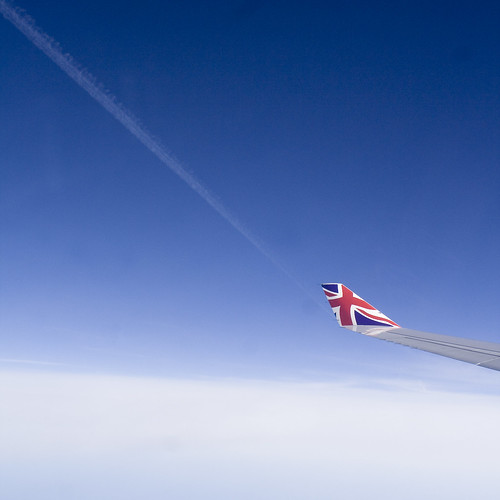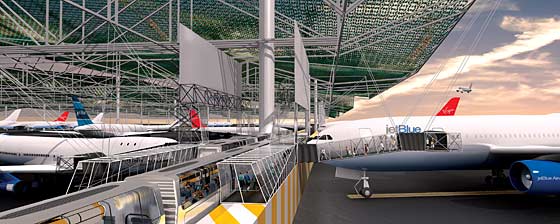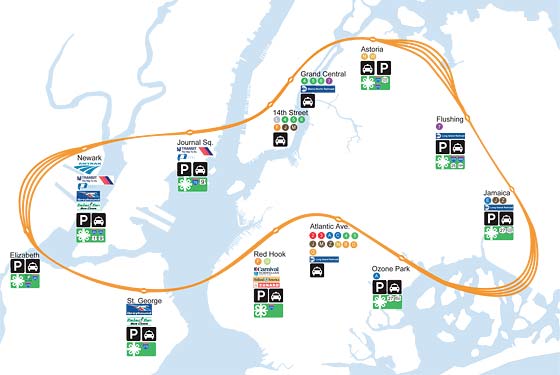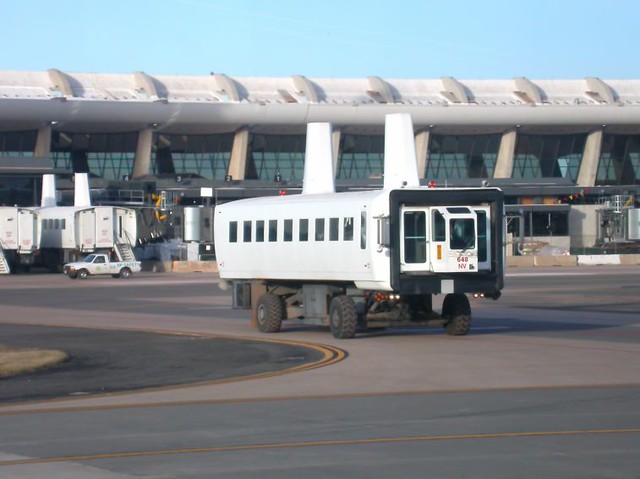Tag: transportation
LIMTV: DoT’s SUPERTRAIN?

The LIMTV (linear induction motor test vehicle) is tested at the Department of Transportation’s high-speed ground test center (now owned and operated by Association of American Railroads) near Pueblo, Colorado, in March of 1973. The experimental vehicle was designed to operate at speeds up to 250 miles per hour, using electro-magnetic forces for noiseless propulsion.
While not exactly the SUPERTRAIN, the 1979 Love Boat-style show set on a huge nuclear-powered train zipping from NYC to LA which I’m obsessed with, the LIMTV undoubtably influenced SUPERTRAIN’S aesthetic. Except LIMTV actually helped pave the way for an actual product using linear induction-based systems, having found a niche with the aid of Bombardier’s Advanced Rapid Transit system. Notable installations are in Vancouver’s SkyTrain and NYC’s JFK AirTrain (below).
Q1 2009 Current Major Transportation Capital Projects in New York City
Over the weekend I was in a conversation discussing the different transportation capital improvements currently in process in the New York City Region. Below is a current list as of the First Quarter (Q1) of 2009 for all major capital improvements by the MTA and the Port Authority. If you step back, there are an amazing amount of infrastructure and transportation capital projects occurring in the NYC Region. Note: capital campaigns are separately funded from the operational budgets. The current MTA budgetary issues are operating, not capital. But without additional funding, in both operating and capital budgets, the current level of service the MTA provides will degrade back in to the 1970’s level of service.
Current Major Transportation Capital Projects in New York City:
South Ferry Terminal
- Status: Grand Opening Today
- New York City Transit (MTA)
- Budget – $530 million (Federal Transit Administration)
The South Ferry Terminal is a new station of the 1 Line in Lower Manhattan replacing the original turn-back loop which can only fit the first five cars. This project was slated to open in early 2009 but has been plagued with accessibility issues and other performance issues.
Today is the official Grand Opening
Second Avenue Subway
- Status: Phase 1 est. completion 2015
- New York City Transit (MTA)
- Current Budget – $337 million (Phase One only)
The first new subway line in over 30 years, the Second Avenue Subway is halfway through Phase One. Phase One includes new tunnels from 105th Street and Second Avenue to 63rd Street and Third Avenue, with new stations along Second Avenue at 96th, 86th and 72nd Streets. Once Phase One is complete, the Q train will be extended from its current terminus at Lex/63rd Street up Second Avenue stopping at 72nd, 86th, and 96th Streets. Phase Two (125th St. to 96th St.) is scheduled for 2014-2017, Phase Three (63rd St. to Houston St.) for 2015-2018 and Phase Four (Houston St. to Hanover Sqr.) 2017-2020. The main reason the project’s schedule is so long is the lack of secured funding.
7 Line Extension
- Status: tunnel boring began – est. completion 2010
- New York City Transit (MTA)
- Extension of the 7 Line west to Tenth Avenue then South to a new 34th Street Station.
- Current Budget – $2 billion (financed by NYC bonds)
Extension of the 7 Line to service the existing Jacob K. Javits Convention Center (the extension was originally proposed for the failed 2012 Olympic Bid and the failed NY Jets Stadium at Hudson Yards). Currently, there is a tunnel boring machine running north from 29th St/11th Ave.
East Side Access
- Status: Tunelling
- Project Completion 2015
- Long Island Railroad (MTA)
- Current Budget – $6.3 billion
East Side Access will bring Long Island Railroad service to Grand Central Terminal using the existing 63rd Street Tunnels and two new sets of tunnels connecting both ends of the 63rd Street Tunnels. One set of approach tunnels pass under the existing Sunnyside Yards while the other tunnels pass under the existing Metro North Tunnels on Park Avenue and terminate at Grand Central. Project is estimated to be complete in 2015.
Fulton Street Transit Center Project
- Status: Unknown
- New York City Transit (MTA)
- Linking 12 Downtown Subway Lines
- Current Budget – $1.4 billion ($497 million from HR-1 Stimulus Package)
Stations served by the 2, 3, 4, 5, A, C, E, J, M, R, W and Z services will be rehabilitated and connected via an east-west underground passageway designed by Grimshaw Architects. A high-visibility Transit Center will be constructed, with entrances on Broadway between Fulton Street and John Street. The station will be handicapped accessible.
World Trade Center Transportation Complex
- Status: Construction of subsurface tunnels
- Port Authority of New York & New Jersey
- New Commuter Rail Station
- Current Budget – $3.2 billion
Designed by Santiago Calatrava, this transit center will house the terminus for the PATH trains at World Trade. Initial foundations are complete and sections of the structure have been erected.
Access to the Region’s Core
- Status: initial contracts
- Port Authority of New York & New Jersey
- New commuter tunnels under the Hudson River to Penn Station
- Current Budget – $8.7 billion (NJ State $2.7 billion, PANYNJ $3 billion, $3 Federal)
ARC is a new two-tunnel (single track) project creating a single-seat trap for New Jersey Transit riders to Penn Station doubling the current capacity. Creation of two new Hudson River tunnels and new deep-cavity terminal connected to Penn Station. The first contracts were announced last week.
Moynihan Station
- Status: unknown
- Amtrak, New Jersey Transit
This project has a particular place in my heart, a project which typifies large capital construction in New York City. Last week Senator Schumer was seeking federal funding for Moynihan Station with Amtrak moving into the future Moynihan Station. Currently the project is in negotiations between the City, State, Federal governments and the two developers involved in the project Related and Vornado. Keep wishing.
Thursday, Snow Again?, Links
- Access to the Region’s Core is Approved and is waiting for funding
- Stimulus draft released; $30B for highways vs. $10B for transit
- OMA’s Zeekracht North Sea wind farm masterplan offers promise of European energy independence
- The Most Gerrymandered Congressional Districts
- Waiting outside the MTA hearing
- By Request: A National Grid?
- Seminal Store Design: SITE Best Stores – you! Watch! Now!
Shovel Ready NY Region Transit List
The New York & New Jersey Congressional Delegations should be advocating these shovel ready
infrastructure projects for the stimulus bill:
- Second Avenue Subway (MTA SAS Page)
- Access to the Regions Core
- East Side Access
- Moynihan Station
- Cross Harbor Movement Project
- Stewart Express
If any of the above projects aren’t on the list, our Delegation isn’t trying too hard.
Access to the Region’s Core in NY Times

I’ve written about Access to the Region’s Core – the new two-track rail tunnel under the Hudson River, but today The New York Times has an extensive write-up of the project, Tunnel Milestone, and More to Come:
But the tunnels reached their peak-hour capacity in 2003 when the Secaucus transfer hub opened. So New Jersey Transit and the Port Authority of New York and New Jersey are planning to spend $7.6 billion to build a second set that will more than double, to 48 an hour, the number of trains that can traverse the Hudson.
The project, called Access to the Region’s Core, or ARC, is in some ways as monumental as the first tunnels, which cost the Pennsylvania Railroad $111 million, a price tag that included the old Pennsylvania Station and four other tunnels under the East River. (It’s about $2.5 billion now when accounting for inflation.)
If federal approval is given this summer and grants are secured later this year, construction will begin in early 2009 and take eight years. Contractors will deploy boring machines the length of football fields to drill through granite, schist and other materials, use laser-guided satellite signals to pinpoint their location, and carve a path under 34th Street so wide that commuters will be able to walk underground to 14 subway lines, and to PATH, Amtrak, New Jersey Transit and Long Island Rail Road trains.
Also see a multimedia explanation about the two different tunnels and what the Future Stewart Express Might Look Like which would utilize the new tunnels.
What the Future Stewart Express Might Look Like

I’ve discussed the Port Authority’s new Hudson tunnel project for Stewart International Airport before but there is a new, if fluffy, article in the WSJ, Sending Fliers Up the River To Ease Traffic:
Stewart Airport, an abandoned Air Force base 60 miles up the Hudson River from Manhattan, is being transformed into a fourth airport for the Port Authority of New York and New Jersey, New York’s airport operator.
…
Chicago proposed creating a third airport in Peotone, Ill., but airlines fought the proposal vehemently. Los Angeles has pumped lots of money into Palmdale, Calif., hoping to make it a reliever for the congested LA Basin, but so far only United Airlines is offering limited, subsidized service.
The idea has worked elsewhere. London’s satellite airports in the countryside have been growing rapidly, driven largely by discounters easyJet and Ryanair. Boston is ringed by several competing airports with commercial service, from big operations at Providence, R.I., and Manchester, N.H., which have become major destinations for Southwest Airlines and others, to fledgling development at Worcester, Mass., and former military bases in Portsmouth, N.H., and Bedford, Mass. Skybus now flies to Portsmouth, formerly Pease Air Force Base about 44 miles from Boston.
What is missing in this cheerleading is investigating why exactly the the airports noted above work. The difference between successful reliever airports, moderately successful reliever airports and unsuccessful reliever airports has everything to do with transportation. London’s Gatwick, Stansted and Luton airports are all successful because they have direct rail links to Central London which takes 30 minutes (Gatwick) to 45 minutes (Luton & Stansted). Additionally, for anyone who has repeatedly flown in and out of London’s Heathrow airport, the chance at flying to a different airport and take a similarly long train to centre London is greatly appealing.1 The Boston airports, Providence, Manchester & Portsmouth all have direct bus connections with Boston’s South Station with an under-hour trip.
For Stewart to become a fully-functioning reliever airport, two things must happen: the three New York airports, La Guardia JFK & Newark must continue their slide into chaos and delay, thus making the trip to Stewart palatable; or, a dedicated single-seat (and quick – a trip of no more then 45 minutes) train service from Stewart-to-Penn Station must be built. Both have costs: time and lost revenue for the airlines, and the cost of connecting Stewart with Penn Station.

Gatwick Express photo by Les Chatfield
Here is how it could be done:
It currently takes 1 hour 33 minutes from Salisbury Mills/Cornwall, the closest Metro-North station, to NY Penn Station with a change at Secaucus Junction.2 The future Stewart Express, would not only need to connect from Salisbury Mills/Cornwall. Suffice to say, this travel time would be trimmed by the Access to the Region’s Core tunnel project, but one problem which will hamper this line is the existing two track right of way. This will need to be upgraded to a minimum three track, but realistically, four track ROW in order to safely operate the Stewart Express to and from Penn Station. An additional staging/repair yard would need to be located somewhere in the system for the additional Stewart Express trains. This is all predicated on being able to purchase, or use the State’s power of eminent domain, to acquire the additional ROW to access Stewart and appropriating the capital expenditure required to build and upgrade the line.

ROW of the mythical Stewart Express
All of this adds up to a very long-term project, which in today’s political climate doesn’t have a great deal of chance without a strong support throughout all levels of government.
- I deeply love waiting in the cattle pen-like security line, or the three different security checks LHR presents current travellers ↩
- Current riders travel 69 minutes on a local train from Salisbury Mills/Cornwall to Secaucus Junction, wait approximately 10 minutes and then take a NJ Transit train an additional 15 minute NY Penn Station. See complete timetable (pdf) ↩
SHoP’s Distributed Airport Terminals

Speaking of transportation paradigms, I remember New York Magazine’s featuring a rethinking of airport travel from SHoP architects:
It’s a high-speed-rail loop, in which trains would serve both as a means of conveyance to the airport and, in effect, as the airport. In a bold new check-in paradigm, passengers would get their boarding passes and go through security at special stations in Union Square and Red Hook (and Astoria and Grand Central and …), then hop on trains that would let them out directly at their plane. Such an approach would have the added benefit of reducing the airport space devoted to terminals, making room for more runways.

Photo-illustration by SHoP Architects
While their proposal to double the amount of runways at JFK is nigh impossible due to the limitations of airspace and safe airplane taxi regulations, this proposal is certainly interesting. A precedent (on a smaller scale) is undoubtedly Eero Saarinen’s Mobile Lounges featured at Dulles International Airport, but on a grand scale. This is a grand gesture in the manner of Daniel Burnham, and because of that, it has zero chance of happening in New York City. However, this plan could be executed quite nicely at a tabla rasa, such as all of those cities China is building.
Michigan Central Station, Detroit
Michigan Central Station (also known as Michigan Central Depot or MCS), built in 1913 for the Michigan Central Railroad, was Detroit, Michigan’s, passenger rail depot from its opening in 1913, when the previous Michigan Central Station burned, until the last Amtrak train pulled away from the station on January 6, 1988.
- Michigan Central Station on Wikipedia
- Michigan Central Station photo set
- Detroit Public Schools Book Depository/Roosevelt Warehouse photo set & blog entry: It will rise from the ashes and another Roosevelt Warehouse photo set

Michigan Central Station, Detroit, originally uploaded by primeau
Port Authority to give $3B to new Hudson tunnel project
 , originally uploaded by michael cinque
, originally uploaded by michael cinque
Another $1B slated for tunnel for the new Hudson rail tunnel named Access to the Region’s Core:
The Port Authority of New York and New Jersey will provide another $1 billion to build a tunnel to carry trains under the Hudson River, bringing its total contribution to the $7.5 billion project to $3 billion.
The authority had committed $2 billion to the tunnel, which is scheduled to be completed by 2017. The agency operates the region’s airports, the bridges and tunnels that carry automobiles between New Jersey and New York City, and the PATH train system.
New Jersey Transit says the tunnel will almost double the number of trains that can travel into Manhattan at rush hour, easing congestion as more commuters switch to mass transit amid rising gas prices and more crowded highways, and reducing travel time into the biggest city in the United States.
…
The authority also will ask the board today to approve a toll increase of $2 on its Hudson River and Staten Island crossings and a 50-cent raise on PATH train fares, the Star-Ledger of Newark reported Wednesday, citing unidentified transportation officials.

The project aims at connecting the Main/Bergen/Pascack Valley Lines of New Jersey Transit with the North East Corridor service. Passengers will be able to take a “one seat journey” to NY Penn Station instead of transferring at Secaucus. A new 6 track terminal facility will be constructed under 34th Street with connections to the existing Penn Station. Additionally, the two new single-track tunnels will be linked to the existing Penn Station facility to facilitate periodic repairs and maintenance on the existing 1917 Hudson Tunnels.

Taking the long view, the linking of the NJ Transit Main/Bergen/Pascack Valley Lines to Penn Station will allow rail service to the Port Authority’s newest airport acquisition, Stewart International Airport, some 55 miles north of NYC via the Port Jervis Line. This rail link will be necessary to make this facility commercially viable, much like the rail links to London’s Gatwick, Stansted and Heathrow airports.



